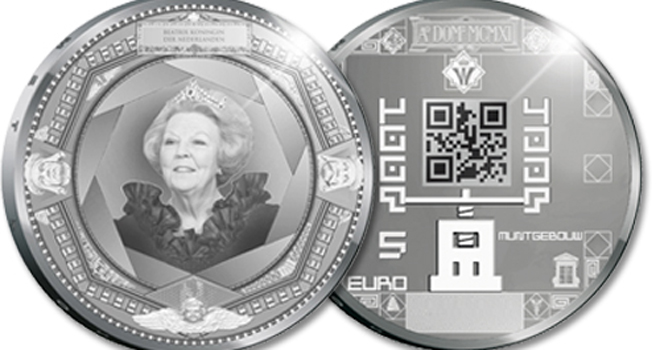You’ve noticed them printed on posters in subways, on corners of magazine ads, billboards, store signs, in books, sometimes on business cards, and even these days on tombstones.
Those black-and-white, square-shaped barcodes popping up everywhere are known as QR Codes, and now for the first time ever, the Royal Dutch Mint in the Netherlands has incorporated the Japanese technology into a new commemorative edition of its five and 10 Euro denomination coins.
The acronym is short for Quick Response Code, and they’re the creation of Toyota subsidiary Denso Wave. They’re used to embed more information than traditional barcodes can encapsulate.
The cool thing about them is that they can be read by ordinary smart phones, and when scanned provide you with more information about whatever object that’s been tagged.
When you scan the special collectors’ edition of the Royal Dutch Mint’s five and 10 Euro coins, it takes you to a web site with more information about the making of the coin, and the 100-year-old building that the coin was issued to celebrate.
The coins are the works of an in-house engraver from within the Royal Dutch Mint, which is unusual, as most designs typically come from outsiders through competitions.
The coin’s symbolism celebrates technology’s long history in forging culture, as well as the possibilities of the future: it features the barcode firmly propped up by a screw press, an antiquated device invented some five centuries ago for coin production.
“They’ve taken this new technology and put it right smack in the middle of the oldest thing,” said Arthur Friedberg, former president of the International Association of Professional Numismatists and author of numerous books on currency.
The design may also be an homage to the screw press that used to sit in the lobby of the Royal Dutch Mint, he added.
The coins are the latest design innovations from a country that’s known for it in the world of coin collectors.
Back in 1990, the mint issued one of the first coins (a silver 50 Guilder coin) that was designed with a computer. There’s also the “Architecture in the Netherlands” coin, which pays tribute to important Dutch architects by featuring Queen Beatrix’s head in the form of a mosaic of the Dutch architects’ names. Then there’s also the “50 Years of Peace and Freedom” coin that featured tiny dots on both sides to create the illusion of a globe.
“For the Dutch this is nothing new,” said Friedberg.”They’ve always been the most innovative in terms of their coin design.”






